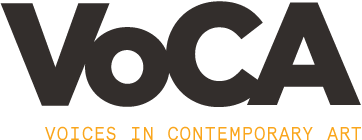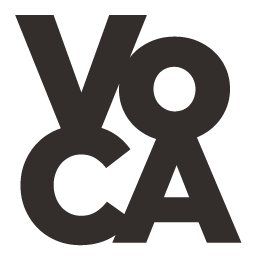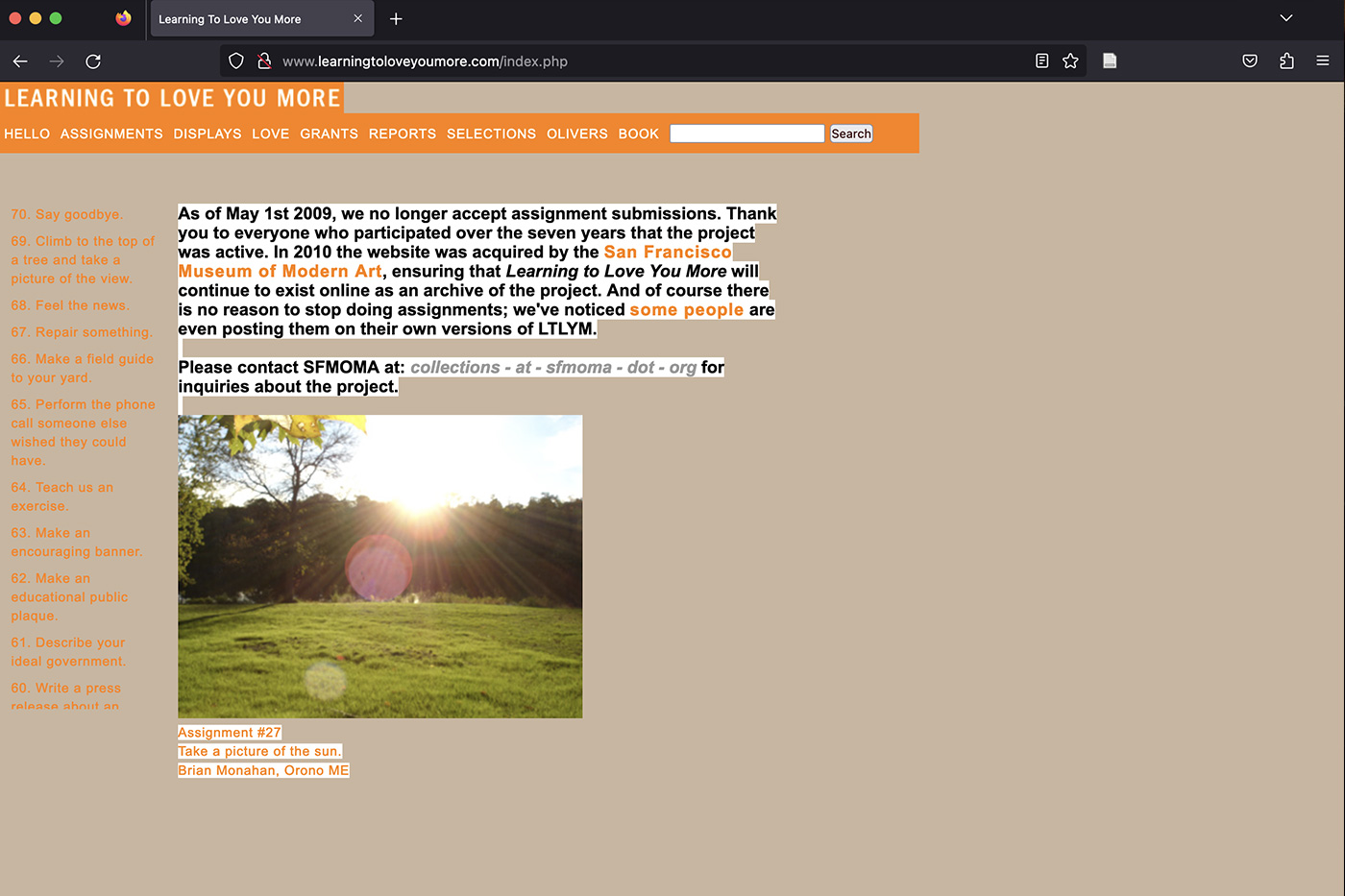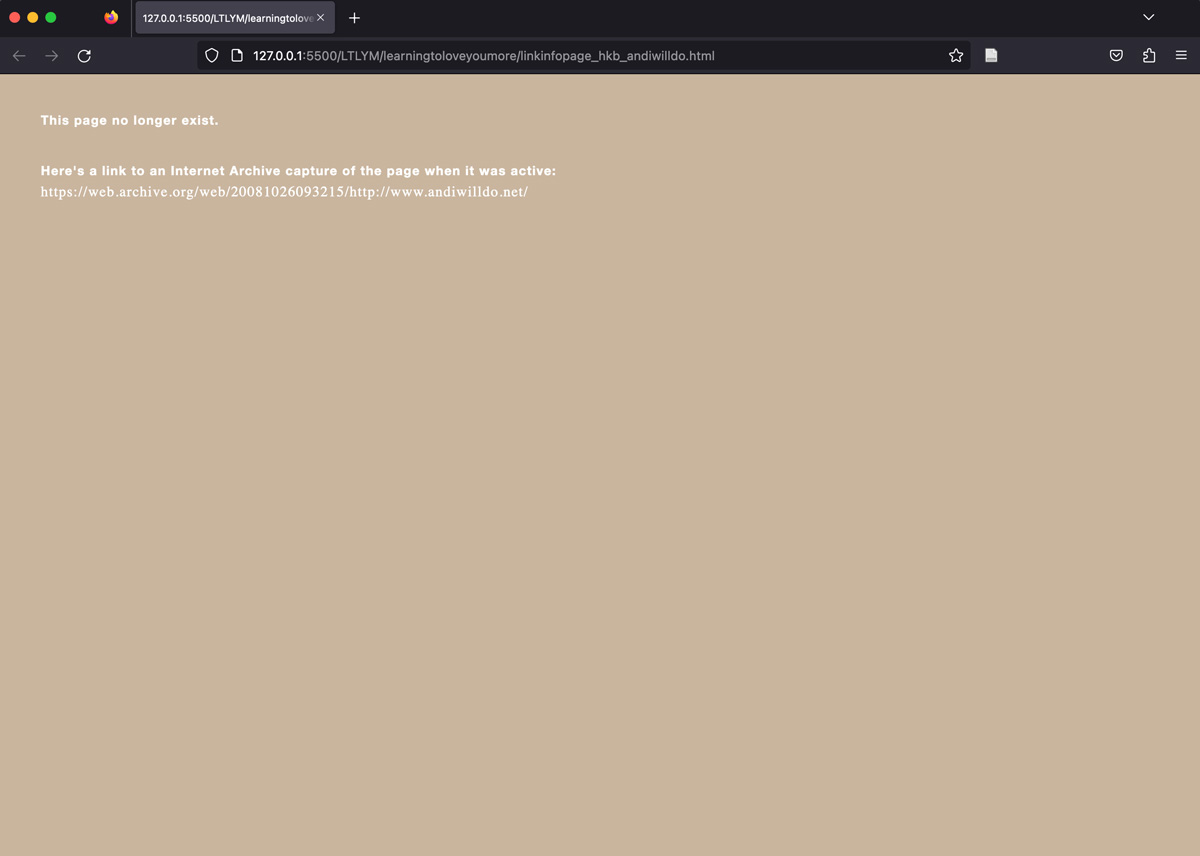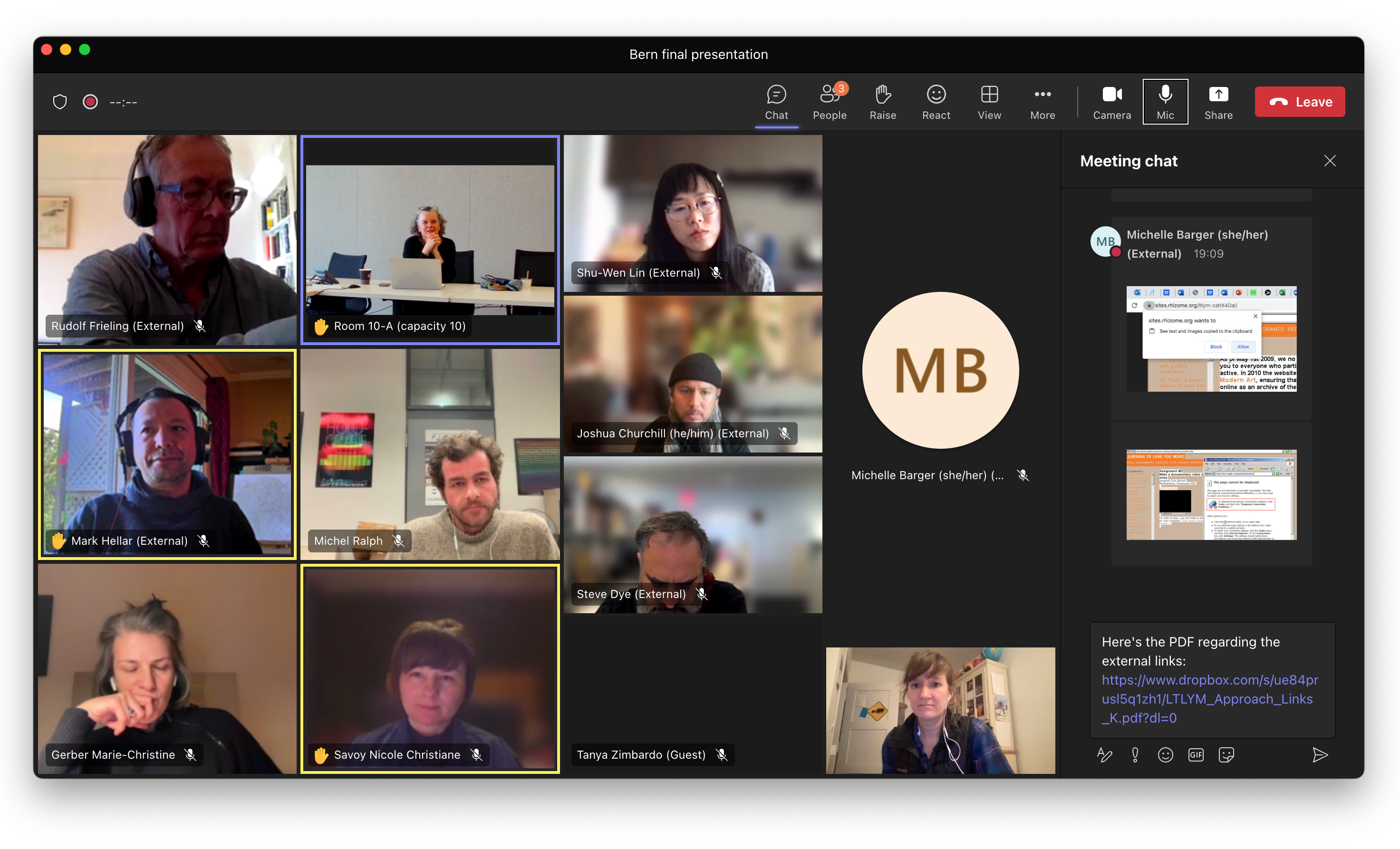Learning To Love You More
Approaches to Conserving Net Art
From September 2021 to February 2023, the Academy of the Arts in Bern collaborated with the San Francisco Museum of Modern Art (SFMOMA) and Rhizome on the preservation of the participatory web-based artwork Learning To Love You More (LTLYM) (2002-09) by Harrell Fletcher and Miranda July.1
Introduction
Assessing, documenting, and conserving artworks from both national and international collections is part of the Academy of the Arts in Bern’s formal conservation training program. The LTLYM project was initiated and headed by co-head and lecturer of the contemporary art conservation program (Modern Materials & Media) at the Academy of the Arts in Bern, Martina Haidvogl, former Associate Media Conservator at SFMOMA.
Against the backdrop of the conservation training program, LTLYM offers a plethora of aspects for not just emerging conservators to immerse themselves in. The artwork manifests as a website, an archive of sent-in memorabilia, and as physical exhibitions curated and interpreted by fellow artists—as stipulated by Fletcher and July—, being installed in and loaned to various institutions. Media-historically, LTLYM precedes early experimentations in social media just before the Web 2.0’s rise of social networking sites like Myspace, Facebook, and YouTube. From a technical point of view, the artwork’s website exhibited several issues, due to obsolescence and the ever-changing landscape of its very own medium—the World Wide Web.
Such issues and manifestations of loss are increasingly common amongst other web-based artworks from the early 2000s. In the last decade, with the rising influx of time-based media and digital art in museum collections, considerable research has been conducted in the relatively new field of net art conservation. Developments continue with increased appreciation for the value and recognition of the vulnerability of these artworks. However, conservation-tried-and-tested approaches as fundamental as condition reporting have yet to be established. The variability of net art, coupled with its often unclear technical and contextual boundaries, has added to the challenge of establishing generalized guidelines for its preservation.2
Bringing such a rich project into a teaching context allows for discussions and deep research along the many avenues it provides, often not attainable within the day-to-day activities of a busy museum schedule.3 With the technical aspects of the artwork’s website as a point of departure, means of documenting and condition reporting the website were identified and established. In a next step, and in close collaboration with both Rhizome and SFMOMA, two operational prototypes of conservation treatments—one emulation, one code migration—, were built, allowing a tangible side-by-side comparison, and providing a firm foundation for decision making. This article summarizes the process from defining the artwork’s conceptual and technical characteristics to developing workflows for assessing its condition, addressing broken links, and evaluating the two prototypes, thus laying out one project’s approach to preserving complex artworks living on the Web.
The Art Project Learning To Love You More
Learning To Love You More was a participatory project that used the Web to encourage anyone with access to the Internet to submit their individual interpretations (reports) of instructions posted online by the artists. It was launched in 2002 and lasted until 2009. The assignments included prompts such as Draw a scene from a movie that made you cry, Perform the phone call someone else wished they could have or Make a video of someone dancing, making them at times lighthearted and at times deeply personal. Over the course of the project, they were consecutively added to the project’s website with simple instructions. The form of report submissions depended on the nature of the assignment and consisted of objects, drawings, written text, links to personal webpages or blogs, photos, and audio-visual media. These submissions were then featured on the website, at times with full address and contact information.4 During the seven years that LTLYM was active, about 8,000 people from all over the world participated and 8,385 reports were submitted, collected, and published on the website by 2009.5
Both Miranda July and Harrell Fletcher have a history of producing conceptual projects with participatory elements and have incorporated themes that democratize the art process and challenge the artist’s and audience’s role.6 Miranda July is an artist, independent filmmaker, performer, and writer who has been producing creative work since the early 1990s. Many of July’s artworks utilize performance, sculpture, technology, and commerce to encourage public participation and interactions between people. 7 Harrell Fletcher is an artist and writer who has been producing socially engaging and collaborative projects since the 1990s.8
In 2009, the artists decided to end the project with their 70th and last assignment, Say Goodbye.9 In 2010, its web project and physical archive were acquired by SFMOMA under the agreement that the museum work with local artists to curate or design future exhibitions, perpetuating its participatory and collaborative nature. Curating artists are free to present and reinterpret the work’s existing content in any form, given the exhibitions uphold LTLYM’s conceptual core.10 With each physical LTLYM instantiation, new layers are added to its wider context.11
Engaging Through the World Wide Web
The assignments came from projects that the artists have either carried out in some form or another, never executed, or from things they were experiencing at the time. They liked the fact that they could post an assignment and that different people would interpret it in their own unique ways. Embracing the diversity of responses, they still wanted people to follow their directions, using the analogy of yoga or following a cooking recipe.
“…what [we] really wanted [participants] to do was just follow the instructions, and that innately, they would do things differently because they were a different individual, had different skills, a different aesthetic interests or whatever it happened to be.”12
Although most people that submitted reports were not artists, it was originally intended that equal parts artists and non-artists would participate. The reports were not evaluated or commented on and there was no hierarchy or concept of originality. If participants followed the directions, their reports were published on the site.13
July and Fletcher had no particular technical interest or experience with building websites when they created LTLYM. However, they were drawn to the Web as a means of communication and collaborated with web designer Yuri Ono to build the site as a platform to engage people to participate in their project.14 The artists wanted people to use the site as an activation point and archive for the experiences and interactions that they were encouraging in the assignments.15 There was no comment or “like”-function as is so omnipresent in social media platforms and their dubious engagement objectives today. Conversely, Fletcher and July used the platform “to get people to leave the website and go do something.”16
Several assignments were intended to connect or reconnect with everyday familiar things by looking at them with new eyes. For example, the assignment Make an exhibition of the art in your parent’s house asked participants to submit images of the art in their parents’ homes with a corresponding text describing how they had viewed it as a child. Some assignments built off others to encourage interactions between participants, like Re-enact a scene from a movie that made someone else cry (Assignment No. #47), where participants were asked to choose a scene from assignment No. #32, Draw a scene from a movie that made you cry.
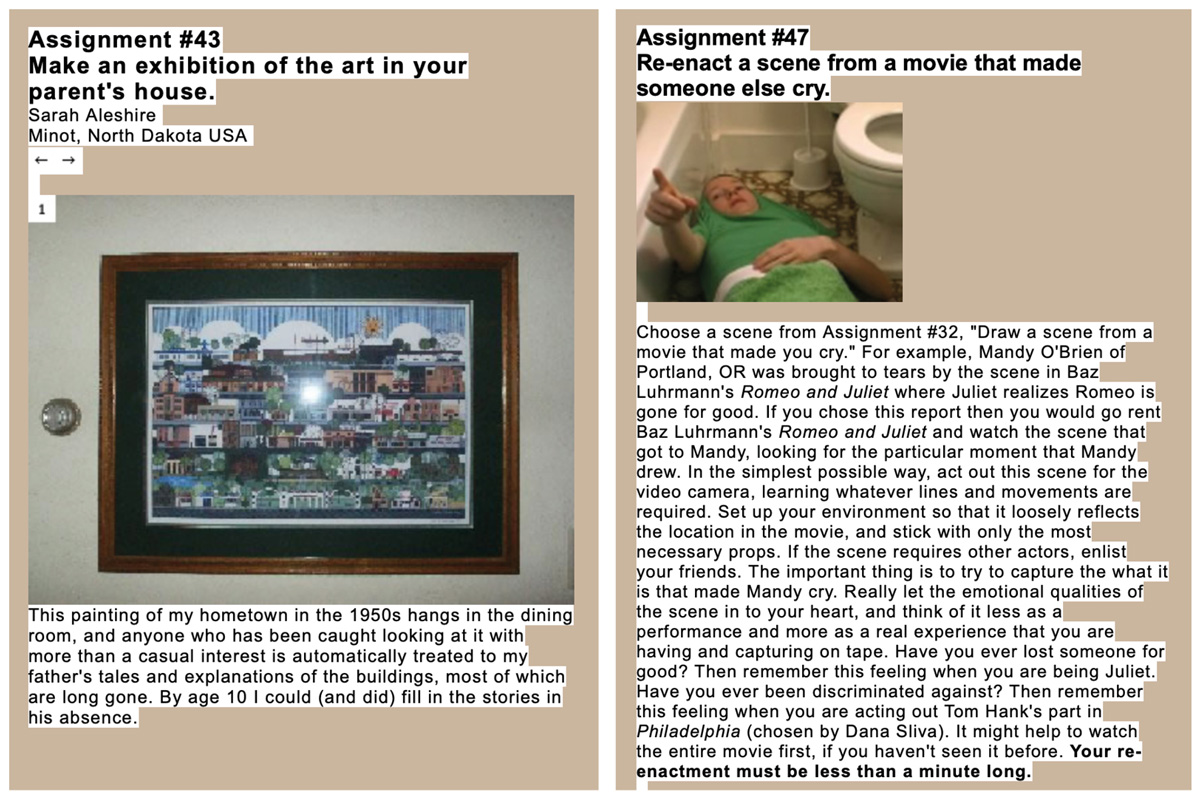
Screenshot of Assignment 43, report Sarah Aleshire, and Assignment 47
(Accessed May 05, 2023, http://www.learningtoloveyoumore.com/reports/43/aleshire_sarah.php, http://www.learningtoloveyoumore.com/reports/47/47.php)
Instruction-based conceptual and participatory art is not new but has taken on many different forms since the 1960s and 70s with Fluxus, happenings, and body art. Artists like Yoko Ono pioneered performances in which the audience’s participation was essential.17 LTLYM extended the concept of audience participation in art to the Web.
Even though the project ended in 2009, LTLYM has continued to inspire people to further its online participatory content beyond the website by completing assignments through their own LTLYM blogs and Instagram posts (see image below). These continuations of the work expand its already blurry conceptual boundaries and serve as a kind of preservation through proliferation.18 Additionally, they speak to the project’s relevance to this day and its invitation to being a part of a shared (online) experience.
The LTLYM website has not accepted assignments since it ended in 2009 but still lives online as an archive of the once active project. However, due to its reliance on the unstable environment of the Web, its visual appearance has changed over time, and most of its large number of audio-visual media files have become unviewable. Additionally, many of its external links have become broken.
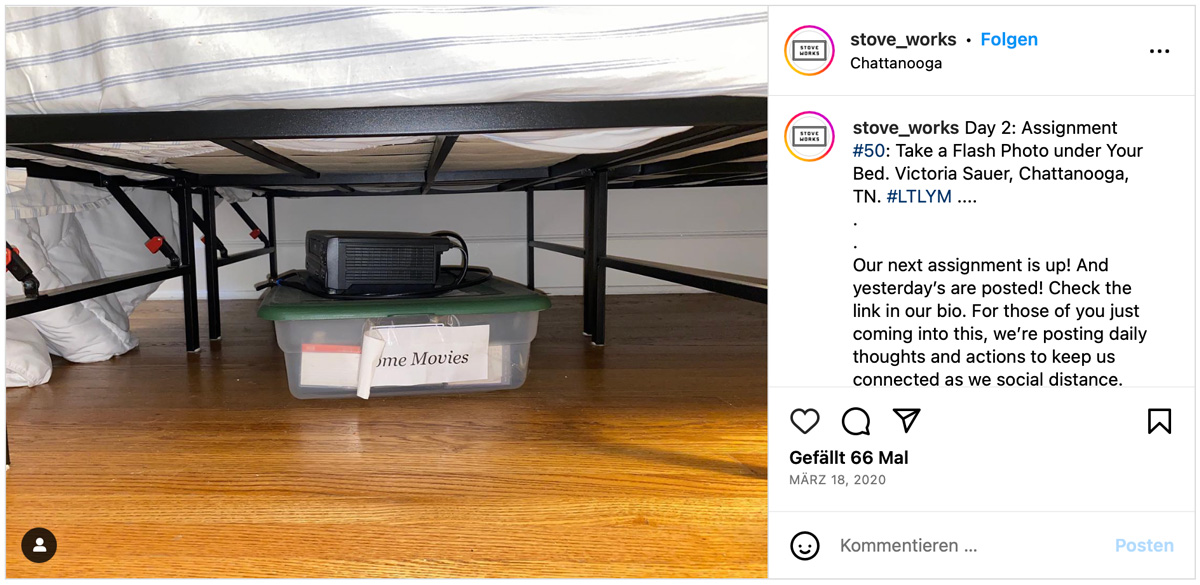
stove_works
“Day 2: Assignment #50: Take a Flash Photo under Your Bed. Victoria Sauer, Chattanooga, TN. #LTLYM”
Instagram, March 18, 2020
Retrieved May 11, 2023
https://www.instagram.com/p/B94CuUOlVEA/
Assessing a Website’s Condition
As with any conservation project, the first step was to assess the work’s condition. Our initial approach in condition reporting LTLYM was performed by comparing the website in different operating systems and browser environments. With over 7000 subpages and a slightly different appearance and functionality in different browsers, the task of condition assessing the website turned out to be quite challenging. During this process, the following issues were revealed:
- All of the video and most of the audio media content was not accessible
- No media player was present in most pages with AV media content
- Many external links were broken
- The search bar did not function
- The original 4:3 aspect ratio did not fit current screens
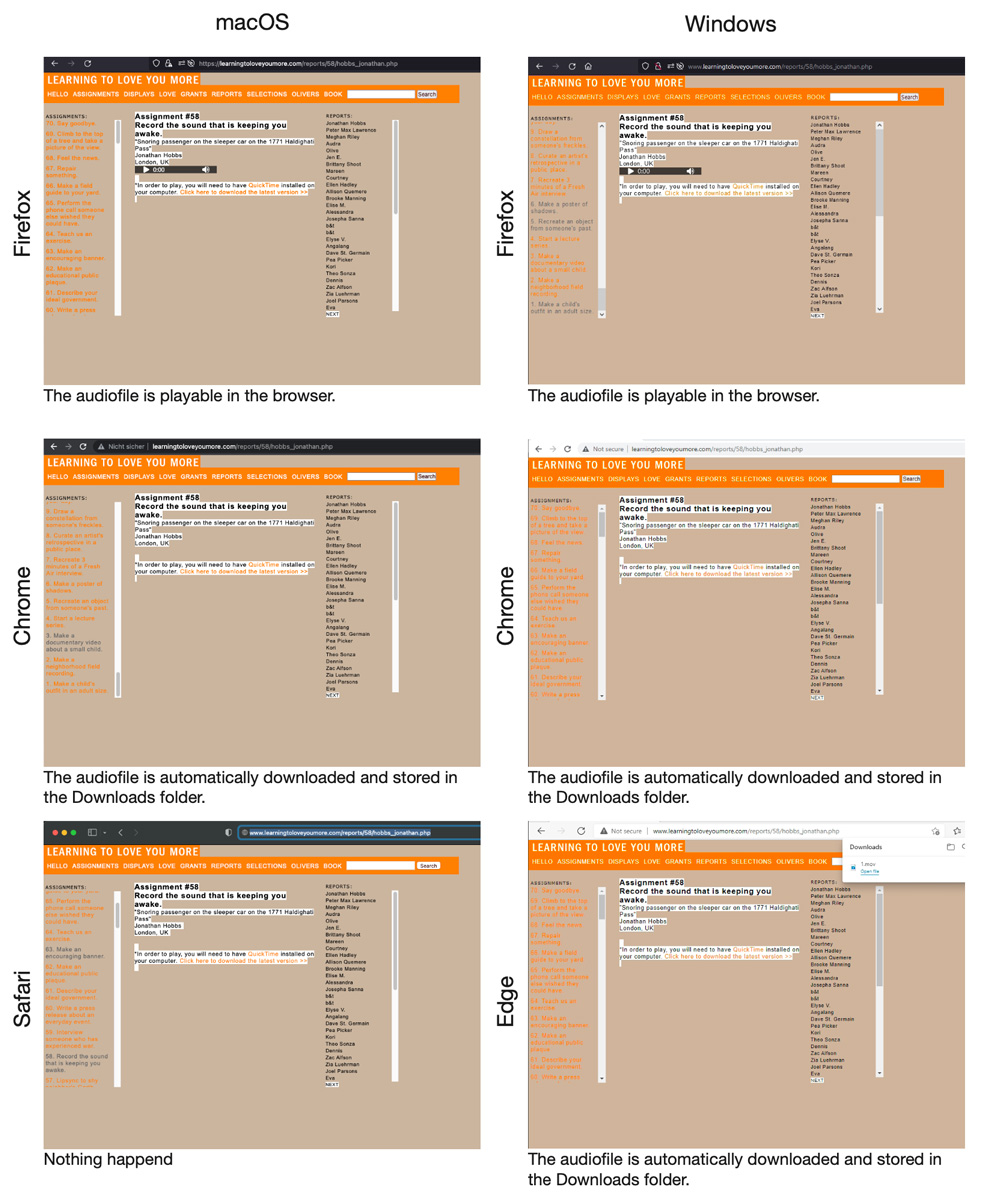
Initial condition report comparing the LTLYM website in different operating system and browser environments
This example shows an audio file which is not accessible in all web browsers
The term ”playable” refers to the accessibility of the media file in the browser
This inspection also led to the categorization of three main components of the website: code, media files, and links. Defining these components gave us a clearer idea of what to look for when checking for loss.
To get more information about the defined individual components and how they relate to each other, we first set up a software development environment to examine the website’s code.19 Tests performed within this development environment, as well as the application of tools for analyzing media files and external links, allowed us to better understand the functionality of the website, how it was built, and how to proceed with our condition reporting process.
To gain a general assessment of LTLYM’s vast number of media files, we decided to focus on individual assignment case studies. We found that original digital and analogue media submitted by participants were compressed and their resolution reduced before being uploaded to the website. This process was a necessary production step due to the low bandwidth of the Internet at the time, which varied widely from region to region and averaged around 1Mbit/s. The low resolution of the site’s media content marks a distinct character feature of the work.
In the 1990s and early 2000s, many websites only functioned in either Netscape Navigator or Internet Explorer. Technologies like plug-ins that worked in one browser did not function in the other. The trend towards web standardization led to browsers using mostly the same technology and websites being accessible in all browsers. Along this path of web standardization and as browser technology developed, many features like plug-ins have become obsolete.20 Even in LTLYM’s relatively short active period (2002-09), the tools used to encode, access, and stream the files in the browser continued to evolve and change, making it difficult to consistently maintain.
The audio and video files were originally accessed with either QuickTime or RealPlayer plug-ins within the browser. In contemporary web browsers, however, most of the media files have become inaccessible and the media players are no longer loading on the page. The legacy versions of QuickTime and RealPlayer used in LTLYM came with plug-ins that enabled old browsers like Internet Explorer 6 to access the files. Accessibility of the media content in LTLYM was dependent on this connection between the legacy browser, media players, and their plug-ins.21 Today, these plug-ins have become obsolete and are no longer recognized in contemporary browsers.
To examine LTLYM’s links, two main software tools were used, Screaming Frog SEO Spider and the Internet Archive’s Wayback Machine.22 Both tools crawl websites and use automated processes to access internet servers. The Internet Archive was useful for retrieving missing content and Screaming Frog was used to generate lists of broken links. Links that were found to have issues were identified in the code and further examined in the software developer environment. These examinations revealed internal links with incorrect file paths and syntax errors in the code, as well as broken external links whose URLs and/or contents had been modified. LTLYM’s external links are especially vulnerable as continued change over time will inevitably lead to further loss.
The LTLYM website’s components each come with their own issues and preservation needs. Since different conservation options exist for each of these components, we decided to test and compare the usability, authenticity, and maintenance requirements of several approaches as functional prototypes. For the code and media files, Ralph Michel developed a migration prototype with the help of Mark Hellar, Technical Consultant at SFMOMA, and Nicole Christiane Savoy worked on an emulation prototype with support from Dragan Espenschied, Preservation Director at Rhizome. For the links, Marie-Christine Gerber developed separate approaches involving tools like the Internet Archive’s Wayback Machine.
Testing Two Prototypes: Migration & Emulation
Emulation and code migration are currently the most widely used methods for conserving net art. Notable recent institutional contributions to the field include Rhizome’s preservation of over 100 digital and net artworks by means of emulation and the Guggenheim’s Conserving Computer-based Art (CCBA) initiative’s preservation of net artworks through code resituation and migration.23
Code migration refers to the process of updating a programming language to a newer version, for example HTML 4.0 to HTML5, or as in the case of LTLYM, converting from one programming language (PHP) to another (HTML). The overall goal is to ensure the continued functionality and performance of the code.
LTLYM was originally written in PHP (recursive acronym for PHP: Hypertext Preprocessor), an open-source, server-side scripting language, normally used to build web applications and dynamic websites with database connections.24 For the migration prototype, it was decided to convert LTLYM’s PHP5 code to contemporary HTML5.25 HTML code is less maintenance-intensive and requires fewer updates than PHP. Despite its many subpages, LTLYM does not utilize a database on its backend, which further supported a choice to migrate to HTML.
This approach required transcoding LTLYM‘s media files to a contemporary format (webm) compatible with HTML5 and the latest browsers. The vp9 codec was used for its compatibility in different browsers and because it is openly documented.26 In this new system, the media files are played directly within the browser utilizing its generic media player, which results in a slightly different appearance of media players depending on the browser used.
The migration prototype was made with the tool Httrack Website Copier to convert the code from PHP to HTML.27 With this tool, it is possible to download complete websites as HTML files, while retaining their media files and link structure. The HTML files can be opened offline in a browser to navigate the website. Although most of the site’s content renders in HTML, some code alterations had to be made, including the JavaScript function on the start page that causes a new report image to appear each time the page is reloaded, and the search bar that used a Google search service which no longer exists. A full migration of the LTLYM website would allow continued hosting on the existing SFMOMA server.
Emulation, on the other hand, would present the website in a historically relevant legacy software environment, without the need to transcode files or migrate the code. Emulators are software that mimic computer systems or environments. They can be built to run obsolete operating systems and other software like legacy versions of Windows, media players and browsers. Emulation allows users to experience the work in the environment in which it was created, without altering its code or files. The media files would be accessed by legacy media players in a browser that supports the players’ plug-ins. Emulation would make LTLYM accessible online, yet it would exist inside emulation software that mimics the website’s historical technical environment.
For the emulation prototype, a legacy environment was built in Rhizome’s Emulation as a Service (EaaS) cloud-based platform with software from LTLYM’s active period.28 This included Windows XP, Internet Explorer 6.0, QuickTime 7.1, and RealPlayer 11.1. In this environment, the website is accessed at its current URL in Internet Explorer via the emulator’s connection to the network.
Viewing the work in the emulator, we can see scroll bars that no longer exist in the live site and its original 4:3 aspect ratio. The JavaScript function that makes a new report image appear each time the homepage loads performs without intervention in this environment. We can also see the legacy media players embedded in the page. Path corrections had to be made in the code to make some media files and links accessible. The media files that no longer play online are accessible in the emulator. Since it is connected to the web, external links using the older http protocol can be accessed from within the emulator as well.29
Although the media files are playable in the emulation prototype, an issue occurs causing them to load very slowly. When the emulator was copied from the EaaS cloud service and run locally, the media files showed no problems with loading or performance. This test shows that since these problems are only observed with the emulator running in EaaS, the slow performance of the media files has something to do with Internet Explorer in the emulator running in the cloud service. To resolve this issue, further time and research are required.

Comparison of screenshots of a report page from LTLYM
Left to right: Current state online with no video access, Migrated to HTML with video access, Emulated with Internet Explorer 6.0 and QuickTime 7.1 accessing the video
Fixing Broken Links
To treat LTLYM’s broken internal links, incorrect file paths and syntax errors were corrected within the code. External links, however, required further attention, many of which returned blank pages or content that was no longer contextually relevant, disrupting the overall experience of the work. The following treatment options were considered for the broken external links:
- Redirecting to Internet Archive’s Wayback Machine captures
- Redirecting to intermediate info pages containing links to Internet Archive captures
Providing viewers with otherwise missing content was a priority in the treatment of broken links. The integration of an intermediate page adds transparency to the treatment process, while also providing contextual information on the links and their respective captures. The Internet Archive captures, however, as well reside on the Web and are susceptible to change and loss. Their use as treatment options would require monitoring of these possible changes.
A multistep approach was applied to the preservation of the broken external links. First, URLs of sites that still existed but had changed, such as the link on LTLYM’s homepage to SFMOMA’s own website, were updated. In a next step, Internet Archive captures were chosen of all links whose original destinations no longer existed on the live Web. One such example was Emma Hedditch’s former website www.andiwilldo.net. Over the past 20 years, ownership of the URL and its content has changed several times. The image below shows a historical outline of these changes.
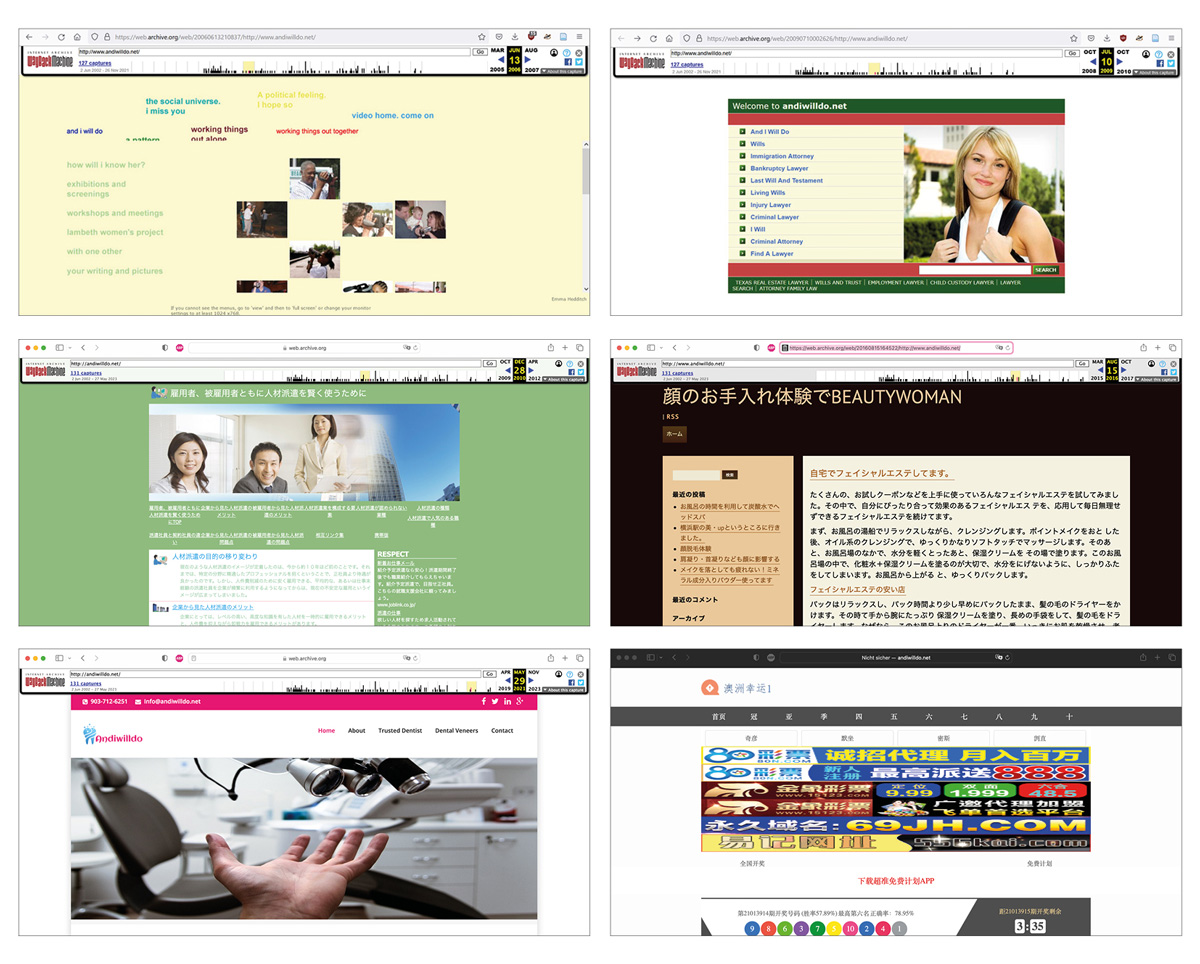
Historical overview of the URL www.andiwilldo.net
Accessed from June 13, 2006 – Jun 2, 2023
http://www.andiwilldo.net/
Historical captures from 2002-09 were retrieved from the Internet Archive. Since such captures are taken randomly, resulting in variable capture dates and completeness, those that most successfully portrayed the links’ contents and functionality from the time they were posted to LTLYM were selected. In the case of Emma Hedditch’s website, a capture from October 2008 was chosen (see below). A prototype of an intermediate info page containing a link to the capture can be seen below as well.
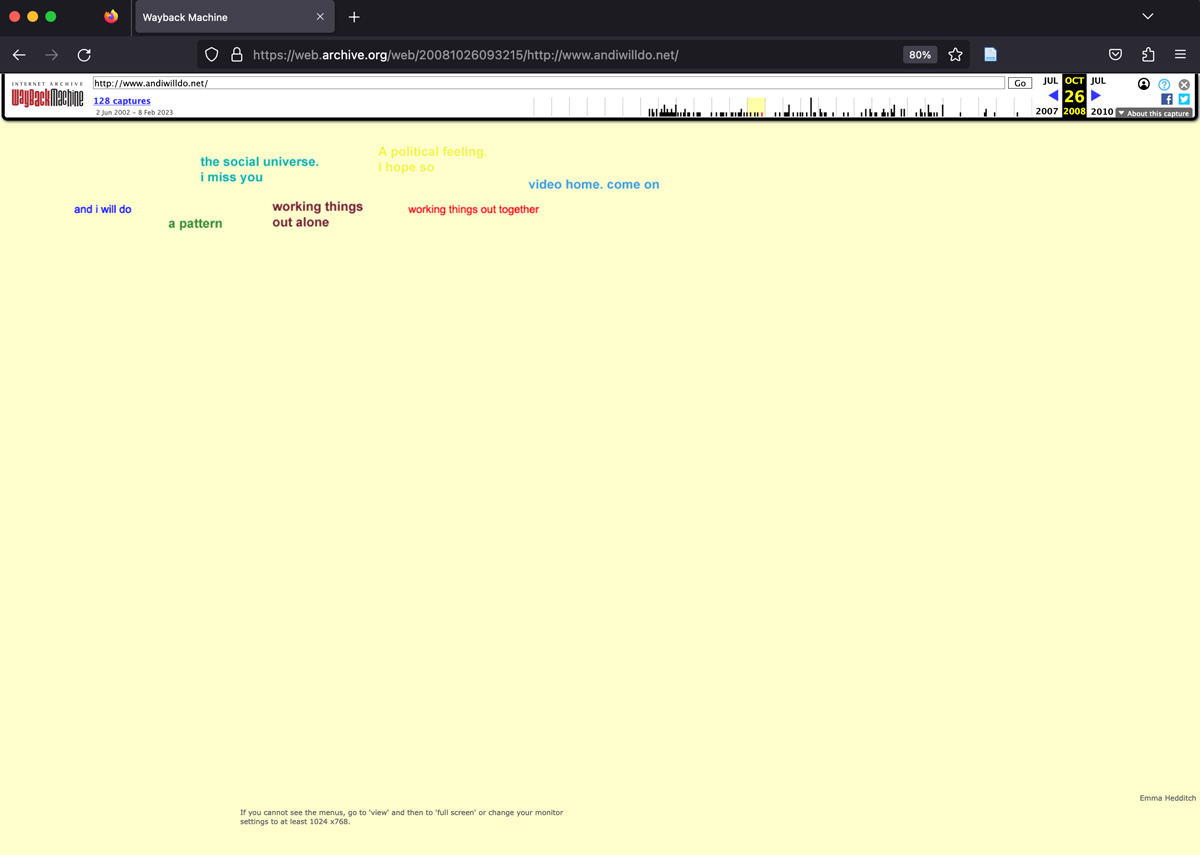
Screenshot of external link “Emma Hedditch”, Wayback Machine snapshot from Oct 26, 2008 in Firefox (version 112.0.2)
Accessed May 11, 2023
https://web.archive.org/web/20081026093215/
http://www.andiwilldo.net/
Conclusion
As Learning To Love You More is inspiring people to participate and create to this day, so does the work stimulate numerous discussions around preservation, art management, and care. Trying to categorize and catalogue such an artwork within our usual tools for museum management very quickly reveals the constraints of our systems and conceptual boundaries. Maria Theodoraki put it most succinctly when she described the artwork as “a museum within a museum,”30 and Ioana Literat compares the artists to a “curator, […] [who] arranges the participant-submitted contributions into a final product that is not unlike an online gallery or museum exhibition,”31 both alluding to the complexity of its many layers.
Over the course of the multiyear-long project, we met with SFMOMA’s team regularly to present and discuss our progress. The meetings were attended by a variety of SFMOMA staff and members of Team Media, who provided valuable feedback.32 At the final meeting, the two interactive prototypes were presented and made available for browsing. By experiencing and interacting with the two workable concepts, more informed decisions could be made. The migrated version allowed the site to be viewed in HTML5, the emulation prototype was accessible at a temporary URL created with Rhizome’s EaaS infrastructure. Different approaches for the links were presented in the form of an interactive PDF. Comparing the prototypes resulted in a rich discussion about the importance of functionality, context, and the meaning of LTLYM.
Viewing LTLYM in a legacy software environment has many research advantages as well as technical art historical value. The emulation prototype deepened our understanding of the artwork and how it and its environment once appeared—and subsequently changed over the active period of the project. However, the slow loading of the videos in the emulator inhibited the user experience and took away from a meaningful comparison of the two options as functional prototypes—the emulator’s historic presentation of the work and that of a contemporary presentation of the migration prototype. Although the aesthetic appearance of the old browser and embedded media players were acknowledged as historically relevant, the group leaned towards the presentation within a modern-day browser. Preference was given to the nearly identical appearance and functionality of the artwork within a familiar environment that allows for an immediate connection with the content, over the experience within a legacy software environment one accesses through a window within the browser window.
A consideration with the migration prototype during discussions both among students and with SFMOMA staff remained the value of the original code and the comments left within it by LTLYM’s web designer Yuri Ono. Deena Engel and Glenn Wharton argue for the value of code in software-based artworks by comparing coding style and comments to the “artist’s fingerprint” or other signs of the artist’s “hand” in a painting.33 There is certainly an argument to be made for the technical art historical value of LTLYM’s original code. Ono’s challenges in maintaining the project as it grew over the course of several years, with the technical constraints of the Web at the time, are reflected in the code. However, the larger context of the artwork itself and the artists’ approach to its technical setup indicates a priority of functionality, contemporaneity, immediacy, and access.
When reviewing the different link options, an intermediate landing page was chosen over a direct link to the respective Internet Archive capture. Giving context as to why a link is not working, while also leading to a relevant archive of it, was preferred over directly linking to the capture. This approach avoids confusion and adds transparency to the fact that a conservation intervention took place, in which an archive was chosen to represent the missing content.
The method of preservation chosen for a net artwork depends on the identity of the work and its technical requirements. Dependencies outside an object’s boundaries, such as external links or libraries, add additional layers of complexity to the decision-making process.34 The meaningful conceptual elements of many net artworks may be successfully preserved and reproduced via emulation or migration alone, whereas others may require a combination of treatments to restore these features. The decision to choose a contemporary solution over a historical one—or vice versa—can be difficult without the opportunity to compare the two. Juxtaposing multiple preservation scenarios benefits the decision-making process and provides a broader context as the work is experienced through these different perspectives.35
Most institutions, including SFMOMA and Rhizome, have limited time and resources to invest in extensive research projects for individual artworks. This particular project pooled resources of three different institutions and allowed for in-depth research that resonated further within each by sparking discourse around these fragile artworks through experiencing proposed solutions within functional prototypes. This cross-institutional project allowed SFMOMA’s team to make a decision by exploring and comparing multiple conservation concepts side-by-side for LTLYM. The emulation prototype provided the museum with the opportunity to test Rhizome’s EaaS infrastructure. By emulating LTLYM, Rhizome expanded its base of legacy software environments. The issue found with the emulation prototype has sparked further research for Rhizome and the EaaS team, as it relates to many other artworks from the same time with similar dependencies. This research will further their continued efforts in tuning the system to support any emulation scenario to accommodate as many artworks as possible.
Collaborations such as these are an important step in the development of the relatively new and variable field of net art conservation. The discussions resulting from comparing different conservation prototypes have led to many more questions relating to the value of the original code, media file formats, software, and external links. With a website having changed several times during its active period, how do we define originality or authenticity of these components? And how should the work be presented today to best represent its full context? Like all time-based media artwork, LTLYM’s preservation and presentation are intrinsically linked. How the work is conserved shapes how it will be presented in the future; how it is perceived depends on its presentation, and this perception adds to its overall story. In a next step, the two prototypes can be presented to Harrell Fletcher, Miranda July, and Yuri Ono, making them a perfect starting point to discuss their preferred strategy of seeing this work into the future.
(Acknowledgements)
We want to thank Dragan Espenschied, Mark Hellar and Lukas Popp who generously provided their extensive knowledge and expertise. Further we thank Elea Breig, a conservation bachelor student at HKB, for her contributions at the beginning of the project. Additionally, this endeavor would not have been possible without the enthusiasm and support from SFMOMA’s team.
1. https://www.sfmoma.org/. Accessed 07.24.2023.; https://rhizome.org. Accessed July 24, 2023.
2. Dragan Espenschied and Klaus Rechert, Fencing Apparently Infinite Objects, in Proceedings of the 15th International Conference on Digital Preservation (Boston, MA: iPRES, 2018), September 24–27, 2018.
3. The ample benefits of a museum-university collaboration around net- and software-based artworks were explored and established through the Guggenheim’s Conserving Computer-based Art (CCBA) Initiative. “The Conserving Computer-Based Art Initiative.” The Guggenheim Museums and Foundation, www.guggenheim.org/conservation/the-conserving-computer-based-art-initiative. Accessed July 24, 2023.
4. This shows the optimistic and according to today’s standards almost naïve approach to the early internet. Since the acquisition of the artwork by SFMOMA, several participants have asked for their submissions to be taken down or be anonymized. These changes to the website’s content (and code) have been tracked within SFMOMA’s internal tool for version control.
5. Demographically, approximately 80% of the submissions came from North America, 10% were from Europe, and another 10% originated from other continents.
6. For examples of other participatory artworks by Miranda July and Harrell Fletcher, see the following links: https://mirandajuly.com/somebody-app/. Accessed July 24, 2023; https://harrellfletcher.com/2006/index3b.html. Accessed July 24, 2023.
7. https://mirandajuly.com/category/art/. Accessed July 24, 2023.
8. CV – Harrell Fletcher. www.harrellfletcher.com/cv. Accessed July 24, 2023.
9. Since no end date was initially established for the project, LTLYM existed as a work in progress. The decision to end it was mainly based on the difficulty of maintaining the website and the numerous participant submissions.
10. See, for example, Stephanie Syjuco’s 2010 installation, commissioned by SFMOMA, that featured every one of the over 7000 submissions on two LCD screens presented inside a wooden structure with a total running time of 36 days. https://www.stephaniesyjuco.com/projects/learning-to-love-you-all. Accessed July 24, 2023.
11. Frieling, Rudolf. “Participatory Art.” In: “A Companion to Digital Art,” ed. by Christiane Paul, (Wiley-Blackwell, 2016), pp. 226–245, https://doi.org/10.1002/9781118475249.ch8.
12. Learning to Love You More – Interview before acquisition (Apr. 22, 2010). In collab. with H. Fletcher, M. July, and R. Frieling. [Unpublished interview].
13. Learning to Love You More – Interview before acquisition (Apr. 22, 2010). In collab. with H. Fletcher, M. July, and R. Frieling. [Unpublished interview].
14. https://www.yuri-ono.com/. Accessed July 24, 2023.
15. San Francisco Museum of Modern Art. “Harrell Fletcher and Miranda July on Learning to Love You More,” 2019. https://www.youtube.com/watch?v=DYMwcFpCFhI. Accessed July 24, 2023.
16. Ibid.
17. One example of a participatory artwork by Yoko Ono is Cut Piece (1964/65). https://www.moma.org/learn/moma_learning/yoko-ono-cut-piece-1964. Accessed July 24, 2023.
18. Rinehart, Richard, and Jon Ippolito (eds.), “Re-Collection: Art, New Media, and Social Memory,” (Cambridge, MA: Leonardo Book Series, The MIT Press, 2014).
19. MAMP was run locally as a server, VSCode was used for code analysis, and a shared GitHub repository provided version control of the modifications within a separate conservation branch. www.mamp.info, https://code.visualstudio.com/, https://github.com/. All accessed July 24, 2023.
20. Hoffman, Jay. “The History of the Browser Wars: When Netscape Met Microsoft.” In: “The History of the Web,” 2017. https://thehistoryoftheweb.com/browser-wars/. Accessed July 24, 2023.
21. RealNetworks, Inc. RealSystem™ G2 Production Guide, 1998-2000. p28, 129, 191; RealNetworks, Inc. RealNetworks Production Guide, 2002, 2004. p43, 486; Beggs, Josh and Thede, Dylan. “Designing Web Audio,” (O’Reilly & Associates, Inc., 2001). https://docstore.mik.ua/orelly/web2/audio/index.htm .
22. https://www.screamingfrog.co.uk/seo-spider/. Accessed July 24, 2023.; https://archive.org. Accessed July 24, 2023.
23. “Net Art Anthology.” NET ART ANTHOLOGY, https://anthology.rhizome.org. Accessed July 24, 2023; “The Conserving Computer-Based Art Initiative.” The Guggenheim Museums and Foundation, www.guggenheim.org/conservation/the-conserving-computer-based-art-initiative. Accessed July 24, 2023.; Engel, Deena, and Joanna Phillips. “Introducing ‘Code Resituation’: Applying the Concept of Minimal Intervention to the Conservation Treatment of Software-Based Art,” 2018., 13.
24. https://www.php.net/. Accessed July 24, 2023.
25. Migration to the latest version of PHP (PHP8) was also considered, however, it was decided to migrate directly to HTML since it would require less maintenance over time.
26. We used the Mozilla Foundation’s Media type and format guide as a guideline for choosing the appropriate codec and container for transcoding the media files. https://developer.mozilla.org/en-US/docs/Web/Media/Formats. Accessed July 24, 2023.
27. https://www.httrack.com/. Accessed July 24, 2023.
28. Espenschied, Dragan. “Emulation or It Didn’t Happen—What to Do about Flash.” Rhizome, 21 Dec. 2020, https://rhizome.org/editorial/2020/dec/21/flash-preservation/. Accessed July 24, 2023.
29. For external links using the https protocol, another solution had to be found. Since Internet Explorer 6, used by the emulator, does not support the cryptographically more secure algorithms used by HTTPS, it cannot display sites that use this new protocol. This means that any sites that were updated to HTTPS are not accessible in the browser. A solution to this issue was tested by creating a local server environment within the emulator containing the website’s files. Instead of the online site, its content stored locally on the virtual machine is accessed by Internet Explorer via the local server. This setup allows the possibility of integrating a web archive of Internet Archive captures, from 2002-09, of LTLYM’s external links. When an external link is accessed in the browser, the Internet Archive capture is rendered via Rhizome’s Webenact proxy service. https://pypi.org/project/pywb/0.7.8. Accessed July 24, 2023.; https://github.com/webrecorder/pywb. Accessed July 24, 2023.
30. Theodoraki, Maria (2018), “Working with Learning to Love You More; A museum inside a museum.” Internal Presentation, 14 May 2018, SFMOMA Archives & Mediawiki.
31. Literat Ioana (2012), “The Work of Art in the Age of Mediated Participation: Crowdsourced Art and Collective Creativity.” International Journal of Communication 6, p. 2974.
32. For more information on SFMOMA’s interdepartmental working group, its history, and formation, see https://www.sfmoma.org/read/team-media-action-contemplation/ (Accessed July 24, 2023) and Haidvogl, Martina et al., “Implementing Cross-Departmental Workflows”, in: Conservation of Time-Based Media Art, Deena Engel and Joanna Phillips (ed.), (Routledge, 2023).
33. Engel, Deena, and Glenn Wharton. “Reading between the Lines: Source Code Documentation as a Conservation Strategy for Software-Based Art.” Studies in Conservation, vol. 59, no. 6, 2014, pp. 404–415, https://doi.org/10.1179/2047058413y.0000000115.
34. In Collecting and Conserving Net Art: Moving beyond Conventional Methods, Annet Dekker defines a network as consisting of linked structures and distribution systems that connect traces, projects and people. Her research explores how net art uses the technology and networked structure of the Web as a medium to create performances, situations, and interactions between people, and how it exists within and is dependent on the ever-evolving Web, causing it to be continually in process and susceptible to change and loss. Dekker, Annet. “Collecting and Conserving Net Art: Moving beyond Conventional Methods,” 1st ed., (London and New York: Routledge, 2018). https://doi.org/10.4324/9781351208635.
35. In 2013, the Whitney Museum of American Art preserved two versions of the web-based artwork The World’s First Collaborative Sentence (1994) by Douglas Davis. An updated version and a historic version were presented side by side on their artport online gallery for net art, https://whitney.org/artport/douglas-davis. Accessed July 24, 2023.
Main image
Screenshot of the LTLYM homepage in Firefox (version 112.0.2)
Accessed May 11, 2023
http://www.learningtoloveyoumore.com/index.php
Image description
A screenshot of a website’s homepage. The page has a gray background; an orange top banner with white letters indicates the name of the site, “LEARNING TO LOVE YOU MORE”, and the different sections of the site. A column to the left lists, in orange letters, the different numbered entries in decreasing order, starting from entry 70. The central part is occupied by a text stating the closure of the project, below which there is a photograph of the sun rising behind a landscape of green trees. The photo caption reads “Assignment #27. Take a picture of the sun. Brian Monahan. Orono ME”.
